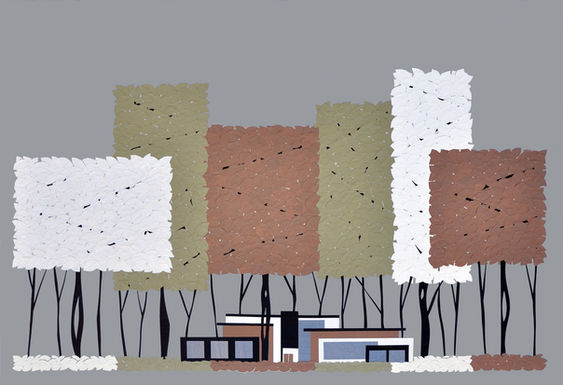
2D/Digital
Chris Wheeler
New to Spring 2025!
Fort Collins, CO
Booth 136
Featured Artist
Chris Wheeler grew up in Philadelphia and stayed in the northeast until he graduated from St. Joseph’s university. Shortly after, he began to travel to Europe for months at a time. He spent most of his days in the art museums and galleries storing ideas and absorbing the creativity. At the age of 26 he moved to Seattle where he began painting and sculpting in a small studio.
Chris spent three years in the Northwest working various jobs and searching for his art form. When he moved to Asia he found an art form that truly appealed to his creative side. He moved to Tainan City, Taiwan where he lived for five years. While in Taiwan he studied art, specifically Chinese landscape painting and calligraphy, but more importantly he learned how to mount works on paper for scrolls and shoji screens. With this skill the artist was able to stretch and manipulate paper in ways very few people can. Almost instantly he began creating his own art using these techniques. He had found his art form and the discoveries he made in Tainan during those years made all of his future work possible.
He returned to Seattle in 2005 and immediately opened Nha Vuu Studio and Design with his wife. The studio restored works of art on paper for galleries, Asian antique dealers and collectors from all over the country. Chris is one of the few people in the US able to do this kind of work. During this time he repaired and rebuilt dozens of shoji screens some 200-300 years old. It wasn’t long before the artist began producing and selling Shoji screens of his own.
Today Chris resides in Fort Collins Colorado with his wife and daughter. He runs two art studios, Nha Vuu Studio and Design and Pergamena Fine Art. He and his wife split their time between Fort Collins and Seattle.
link to Buzz Feed Magazine Article
https://pergamenafineart.com/meet-chris-wheeler-of-pergamena-fine-art-feb-2021/
I spent three years in the Northwest working various jobs and searching for my art form. When I moved to Tainan City, Taiwan I found an art form that truly appealed to my creative side. While in Taiwan I studied art, specifically Chinese landscape painting and calligraphy, but more importantly I learned how to mount works on paper for scrolls and shoji screens. With this skill the I was able to stretch and manipulate paper in ways very few people can. Almost instantly I began creating art using these techniques. The discoveries I made in Tainan during those years made all of his future work possible. My art is a combination of drawing, painting and sculpting. The imagery comes from long-standing commitments to modernist conventions. The simplistic forms are an attempt to tap into the memories and ideas we all share. I’ve found my minimalist designs appeal to people on a primitive level. I first start by stretching handmade paper made of cotton, mulberry and straw, on large 4x8 boards. Medium body acrylics are then used to texture the surface, however sometimes the paper is left in its natural color to add an organic element to the artwork. Each shape is then cut freehand giving the piece’s crisp edges as well as organic character. Wheat paste that is shipped from Japan in a powder form, is boiled down with water and then pushed through a horse hair strainer to remove all fine lumps. The glue is then applied with a wide brush to the back of each piece and placed on the artwork making sure that all excess glue and bubbles are removed between each application. This technique is only known by a handful of artisans in the United States and traditionally used to restore antique shoji screens and scrolls.



















